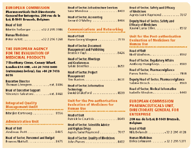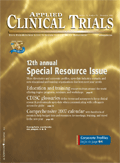European Regulatory Agencies Update
Along with the titles and phone numbers of personnel, View from Brussels columnist Peter O'Donnell gives an update on the regulatory front in Europe.
Peter O'Donnell, the View from Brussels columnist for Applied Clinical Trials, is a freelance journalist who specializes in European health affairs. He is based in Brussels, Belgium.
This was the first full year of the European Union's revised medicines legislation, which came into force late in 2005. New legal provisions gave the European Medicines Agency in London responsibility for evaluating generic and biosimilar medicines, "compassionate use" medicines, medicines for use outside the EU, and "core dossier" applications for pandemic-influenza vaccines. All new medicines for HIV/Aids, cancer, diabetes, neurodegenerative disorders, and "orphan" diseases now have to be submitted through the centralized authorization procedure.

Statistics compiled early in 2006 showed that 43 initial marketing authorization applications for new medicines for human use were received by the agency in 2005—slightly up from the 40 in 2004. During 2006, a sharper upward trend led to forecasts of 62 applications for all of 2006, rising to a likely 79 in 2007, boosted in part by the emergence of the first "biosimilars"—in effect, generics of biological products. Demands for orphan status remained strong, with 77 requests for official designation in just the first nine months of 2006.
The EU regulation on pediatric medicines completed its legislative process during the year, and the agency is now making plans to establish in 2007 the new Paediatric Committee, which will provide opinions on Paediatric Investigation Plans, plus coordinating a pediatric research network and providing information on pediatric clinical trials.
As a result, the workload is expected to continue to increase. In addition, from the beginning of 2007 the EU will grow again, from its current 25 member states to 27, with the accession of Bulgaria and Romania. So while the EMEA's budget already rose to x123.6 million in 2006, up from the 2005 figure of x111.8 million, further increases are expected for 2007, along with additional staff.

Transparency became a hot topic in 2006—partly in response to more general moves within the EU to open up increasingly to public scrutiny. During the year the agency published extensive information on withdrawals of applications for authorization, and agreed to publish many of its own meeting agendas and minutes. Mechanisms to prevent conflicts of interest—principally wider requirements on disclosure—were also extended in a bid to provide reassurance on impartiality and independence among regulatory agencies.
As part of this trend, 2006 also saw the introduction of a new framework for developing relations with the agency's stakeholders, focusing in particular on patient, consumer, and health care professional organizations and on the provision of information about medicines to the public. This has led to increased interaction with patient and consumer groups. As can be seen from the accompanying table, the agency's management board now includes representatives of patient groups and medical organizations.
The first meeting took place of the EU Pharmaceutical Forum, a high-level group of ministers from the 25 member states, raising some slender hopes of improved conditions for the stimulation of research and development in Europe. One small improvement in the general European context since 2005 is that there is a growing consensus on the merits of a vigorous European pharmaceutical industry. But there is still little sign of consensus over how to sustain it, with pressures increasing from health care financing agencies for ever-tougher cost–benefit assessments of medicines.
The year was punctuated by repeated warnings from the research-based industry—and the clinical trials community—over the risk that Europe was becoming steadily less attractive as a base. Part of the argument is economic: Pricing regimes in Europe remain tough in many member states, and widespread parallel importing continues to erode industry revenues. But part of the argument relates more to the climate for investment, research, and enterprise in Europe.

FDA Fast Tracks Johnson & Johnson’s Nipocalimab for Fetal Neonatal Alloimmune Thrombocytopenia
March 27th 2024Johnson & Johnson is moving forward with a pair of Phase III trials of nipocalimab to reduce the risk of fetal neonatal alloimmune thrombocytopenia in alloimmunized pregnant patients.